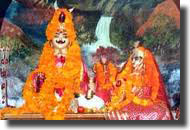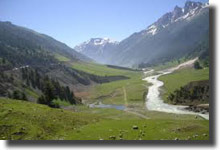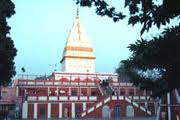Location :
The premises of the Ranbireshwar temple are divided into two halls which are decorated by images of the Gods namely Ganesha and Kartikeya. There are idols of the faithful Nandi Bull in the temple. There are about 1.25 lakh bona lingams of the Lord Shiva placed in the two halls of the temple. The main characteristic feature of Ranbireshwar temple is the 7.5 feet tall Shiva lingam that is placed in the main sanctum of the temple and the main lingam rises in the center of the temple and is of black marble stone.
Who build the temple and when

Maharaja Ranbir Singh is one who has built the temple who is one of the ancestors of the Dogra rulers of the state of Jammu and Kashmir. The temple is dedicated to Lord Shiva who is a part of the holy trinity of the Hindu mythology. In the year 1883, the construction of Ranbireshwar temple was completed.
Good time to visit the temple is during September and April. All the facilities including accommodation are available these days near the temple.
Other places to Visit
Peer Khoh
It is an ancient cave where Shiva Lingam which is believed to have been formed naturally, is located near the Jammu valley. Peer Khoh is considered as one of the major attractions of Jammu & Kashmir pilgrim tourism as it reflects the natural wonders of the state. It is popularly known as a cave shrine consisting of two natural caves. The first one has a maximum height of 5 feet, the second cave is a bit broader and spans to around 12 feet. The temple of Peer Khoh is enshrined with the gracious presence of Lingam of Lord Shiva and is visited by huge number of Hindu devotees every year.

In the early 20th century, the temple suffered from an earthquake, and the then Raja Sansar Chand made an effort to renovate the temple after the calamity. The temple complex acquires lush green gardens, which makes a perfect foreground to the ancient and unique structure of this temple.
Peer Baba
Peer Baba is the the dargah of a legendary figure Peer Budhan Ali Shah, which is always very much crowded by the destination of believers. This kind of Muslim saint is assumed to have lived upto the age of 500 years by supporting his life entirely on milk. The Muslim saint was a close friend of the tenth and the last guru of Sikhs, Guru Gobind Singh. Irrespective of the diverse caste and religion, believers throng this place on Thursdays to offer prayers and respect to the legendary saint.
Peer Baba is the famous Dargah (tomb) of the Muslim saint, Peer Budhan Ali Shah. On Thursdays apart from Muslims, Hindus and Sikhs also come in large numbers to pay respect to the Saint. The Dargah (shrine) of Peer Budhan Ali Shah or Peer Baba is said to protect the people of this city from mishaps and evil spirits. A friend of Guru Gobind Singh, it is said that Peer Baba lived his entire life on milk alone and lived to the age of five hundred and still people from all faiths and religions verate him in equal respect.
Peer Mitha was a saint who has a shrine of his own and was a contemporary of Ajaib Dev and Ghareeb Nath, who were famous for their prophecies and miracles. 'Mitha' means 'the sweet one' and the saint was so-called, as the Peer would accept nothing more than a pinch of sugar in offering from his devotees.
Bave Wali Mata Temple
Bave Wali Mata (Goddess Mahakali) which is the Bahu fort today serves as a religious temple is situated on the left bank of the river Tawi. The temple is perhaps the oldest fort constructed originally by Raja Bahulochan over 3,000 years ago. The temple is dedicated to the Goddess Kali popularly known as Bave wali Mata.
| Bave Wali Mata Temple is inside Bahu Fort. It is the presiding deity of Jammu, the best time to visit is Tuesday and Sunday which are considered as special days for worship of devotees. The Bahu Fort is surrounded by a beautiful terraced garden. This temple is considered second only to Mata Vaishno Devi. | Nearby tourist places to Ranbireshwar Temple
Jammu Srinagar |
 |
Transport facilities to Ranbireshwar Temple
- By Air :Indian Airlines and Jet Airways operate flights to and fro from Jammu to Delhi, Chandigarh, Leh and Srinagar. From the airport taxis and auto-rickshaws are available for the city.
- By Train : Jammu is a major rail terminus and connected to Delhi through a number of convenient overnight trains. Jammu railway station has good rail connections with other parts of the country as well. Several fast and super-fast trains ply to Jammu from Guwahati, Kolkata, Mumbai, Chennai and Bangalore.
- By Road : Jammu is situated on National Highway 1 A and is well-linked to Delhi on NH 1 via Jalandhar, and other parts of the country. Jammu is also connected by road with Srinagar and Ladakh. Tourist taxis are best mode of local transport in Jammu.



